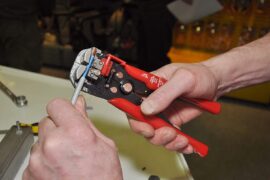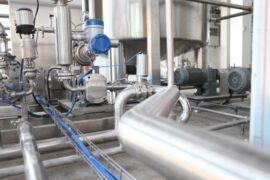Years of advancement have brought technology closer to us. One proof of this is the 3D printer that we can now enjoy in the comfort of our homes.
Compared to the conventional document printers that produce nothing but two-dimensional letters and images, 3D printers can give you more. As its name implies, it is capable of producing products in three dimensions which makes it an ideal machine for the production of objects in small units.
This is possible through the use of a computer-aided design model (CAD) or a digital 3D model. They serve as the guide of the 3D printer machine in building the overall structure of your project. With this, the tool can produce a variety of printed objects that can offer us a variety of purposes; be it for leisure, education, or industrial production purposes.
On the other hand, the process of its production depends on the type of the 3D printer. Generally, there are lots of types of 3D printers but only a few of them exist such as the Fused Deposition Modeling (FDM), Stereolithography Apparatus (SLA), Digital Light Processing (DLP), Selective Laser Sintering (SLS), Electron Beam Melting (EMB), Laminated Object Manufacturing (LOM), Selective Laser Melting (SLM), Binder Jetting (BJ), and Material Jetting or Wax Casting.
Types of 3D Printers
Of all the nine 3D printer types that are currently available, only three of them are prevalent due to the simplicity, accuracy, and convenience they offer to users.
Fused Deposition Modeling
The process of FDM works by heating and melting thermoplastic filaments. The filament would then be extruded by the printer nozzle to construct the object layer by layer, starting from bottom to top. It moves in a Z-direction and deposits the melted filament in X and Y coordinates.
To do this, a specialized program (also called “Slicers”) would divide or cut your CAD models into layers. After this, it would be easier for the printer to determine how it would print each layer of your project.
And although an FDM printer takes time producing objects, it can work on intricate designs making it ideal for prototyping. And since it commonly uses non-toxic filaments such as PLA, it can also aid safely in the packaging of foods and drugs.
Nonetheless, FDM has also been found useful in the printing of ready-to-use objects like legos and other plastic gears. The products are produced with excellent thermal and chemical attributes due to the kind of production-grade thermoplastics commonly used in such a kind of printer.
If you are someone who’s eyeing the food, toy, or automobile manufacturing industry or someone who simply wants to explore the world of 3D printing without any fuss, an FDM 3D printer is the best choice for you.
Stereolithography Apparatus
SLA 3D printers oftentimes produce smooth finish in printed objects. It takes at least six to eight hours of production just to finish a small model. Conversely, it can take several days for an SLA printer to finish a large project model.
In SLA printers, models are printed by exposing the photosensitive liquid resin to the UV-laser beam controlled by the printer. The layers of resin currently exposed to the laser then solidify and a stage of the printer lowers in the tank so the laser could expose another layer and harden the resin to its rightful form. The process of the laser beam moving geometrically from point to point continues until the model is finished.
After the printing, the object needs to be rinsed using a solvent and to be put in an ultra-violet oven or curing station in order to achieve complete bond formation and increase in material properties.
With its intricate process, SLA has become a notable 3D printing process for the creation of prototypes for medical modelings, such as detailed and accurate 3D models of human anatomical regions.
Selective Laser Sintering
SLS is one of the most expensive 3D printers available in the market. That said, it is most commonly used by manufacturing companies instead of 3D printer enthusiasts at home.
The distinctive thing about this type of printer is that it uses strong lasers in forming 3D models. In its vat, it utilizes powdered materials instead of a liquid resin.
It sinters and binds small particles of polymer powder and forms the structure of the CAD model. And because of this, it doesn’t have the need for support structures as the printing process happens with the unsintered powder around.
This also makes it easier for users to print models with delicate and detailed designs with ease. That being said, it is a top pick for engineers and manufacturers who are in need of rapid prototyping. Also, it is a more economical option for injection molding and the production of custom and complex parts for end products.
Top Five Best 2020-2021 3D Printers
Besides considering the main function of the 3D printer you are looking for, it is also essential to look for a quality printer that can offer excellent features. With such details, you can be sure that you can print your CAD models with absolute precision and flawlessness.
Here are the top 5 best 3D printers we assessed from 2020 to 2021 together with our group of experts. Click on the buttons below to have a peek at their best bargains on Amazon.
Best 2020-2021 3D Printers Comparison & Rating
1. Creality Ender 3 Pro 3D Printer
Creality Ender 3 Pro 3D Printer has one of the most impressive power supplies in the world of 3D printing. It can heat its hotbed to 110℃ in just 5 minutes which allows faster production of models. The new 40X40 Y-axis design of the printer is also a nice plus in the stability and precision of the process. The magnetic plate is also a sweet detail of Creality Ender 3 Pro as the printed model will always and mostly peel right off after cooling. You’ll also have quality parts for the frame of the unit as they all come in metal. So, expect a sturdy 3D printer with aluminum extrusions that can efficiently mold your models. With this, it is no doubt why this is one of the widely-used 3D printers where you can receive boatloads of support from various platform communities.
2. ELEGOO Mars 2 Mono MSLA 3D Printer/UV Photocuring LCD Resin 3D Printer
The ELEGOO Mars 2 can provide you a smooth printed product, thanks to its 2K mono LCD and COB light source structure that emits a more even UV light (wavelength 405 nm). It comes with a Z accuracy of 0.00125 mm and an XY resolution of 0.05 mm. Its .ctb format is capable of reducing sliced file size by an average of 90% and it offers 8 times better anti-aliasing features compared to other cheap brands. The build plate with a sandblast design also helps a lot in the steady and consistent production of quality prints. We also commend that it has an operating system that supports various languages: Chinese, English, Japanese, Dutch, Korean, French, German, Russian, Italian, Spanish, Turkish, and Portuguese.
3. FlashForge 3D Printer Creator Pro
FlashForge Creator Pro has good positioning precision with XY at 11 microns (0.0004 in) and Z at 2.5 microns (0.0001 in). It can work on extremely detailed projects through its 0.4 mm nozzle diameter. The model comes with straightforward, simple, and user-friendly instructions and a slicer which is great for new users. Also, it comes pretty much assembled, so you can use it after some minutes completing the assembly of the unit. During our test, it was able to produce clean, flawless test prints. However, keep in mind that although it is compatible with a great number of filaments, it worked the best with PLA and ABS during our test.
4. Dremel Digilab 3D20-01 3D Printer
It is true that Dremel Digilab 3D20-01 is one of the most reliable 3D printers in the market. It is capable of delivering clean and accurate prints with any CAD software of your choice. Due to its open system, you can also easily download and print free models around the web. It also has high-quality models pre-loaded on it that you can access and print rightaway. The structure of the model is well-designed as well. Its enclosed chamber design doesn’t only give it a luxurious look, but it also helps in stabilizing the temperature needed for a successful printing procedure.
5. LONGER Orange 10 Resin SLA 3D Printer
The impressive thing about this entry-level 3D printer is its small angle UV LED matrix. Compared to most UV LED designs that give limited light coverage, the LONGER 3D printer has a better optical path design and uniformity of light source which results in fast curing. It also has a resin flow-back design that prevents drips and waste of the material. And with its standard printing size of 3.86 x 2.17 x 5.5 inches, it can meet the needs of most designers and enthusiasts. Lastly, we love its smart support and fast slicing feature that automatically detects any suspended parts and adds cross-linked grid support to the model.
Best 2020-2021 3D Printers - Buyer's Guide
Always consider the type of 3D printer you are about to purchase as they contribute a lot to your comfort. One of the most commonly used 3D printers is the FDM printer as it is more doable for most projects. Also, compared to other printers, it offers neat production which is commonly the challenge in SLA printers that use resin as the primary material.
If you intend to use the printer for a casual production of models in small sizes, most commercial 3D printers would suit you. However, if you intend to have bigger projects, better to look for printers with huge printing capacity and area.
SLA printers use resin to print models. If the sticky nature of this material won’t bother you, you can go for a printer like this. FDM printers, on the other hand, are more versatile when it comes to the materials they are using for their printing production. They can use a variety of filaments ranging from PP, PLA, ABS, PLA Color Change, Pearl, ABS Pro, elastic, PVA, HIPS, PETG, TPE, TPU, conductive filament, flexible filament, metal-filled filament, wood-filled filament, and more. Also, it is best to have an FDM printer that can cater to most of these filament types.
Most 3D printers come with a free slicer software and it is a good point to consider when buying a unit. However, do spend some time assessing and doing research if the software that the printer is using is user-friendly. This is particularly important if you are new to the 3D printing process.
To get the best out of your purchase, scrutinize the unit and make sure that it offers new and high-tech features that will make your experience easier and flawless. It could range from battery protection, memory feature, LED control panels, covered chamber, number of nozzles, positioning of lights, and so on.
Best 2020-2021 3D Printers - FAQs
Besides using it in prototyping and manufacturing parts, you can also use it to print models for medical purposes. This also makes it an ideal tool that can be integrated into educational curriculums.
Every 3D printer builds products using the principle of turning a digital model (CAD) into a three-dimensional model. It does it by printing the parts layer by layer which results in the process being called Additive Manufacturing.
Various companies and businesses from various industries are using 3D printers for specific purposes. For instance, professionals in the medical field use it to print models of human body parts and internal organs in order to have a better view of a patient’s condition. They are also used for prototyping and manufacturing small parts of particular products. For example, 3D printers are greatly used by automotive companies like Volvo, BMW, and Ford for rapid prototyping and product development.
First of all, every 3D printer has its limitations when it comes to the size capacity of the project it can print. Also, you need a specific set of knowledge and skills in CAD software in order to produce excellent model layouts.











